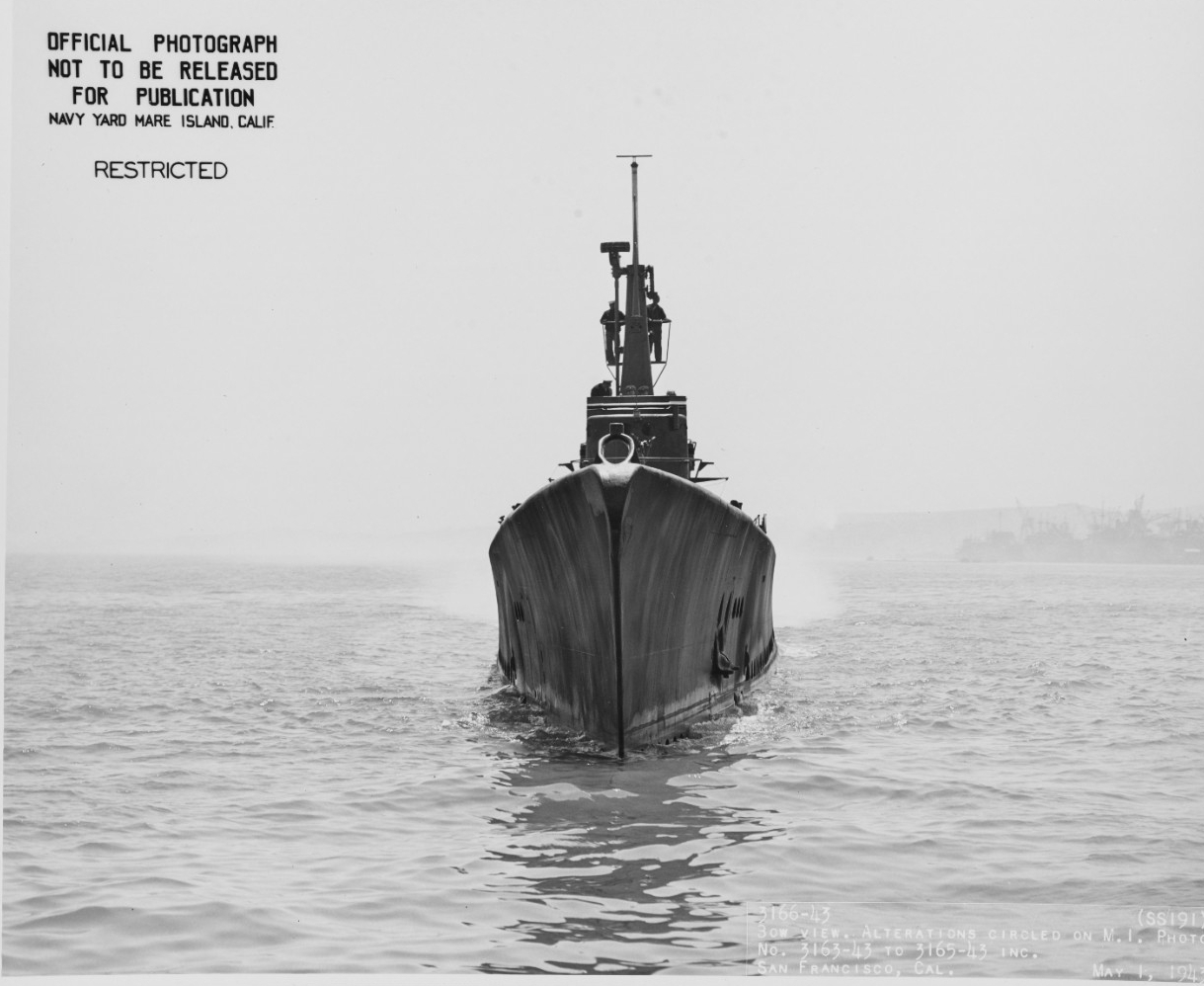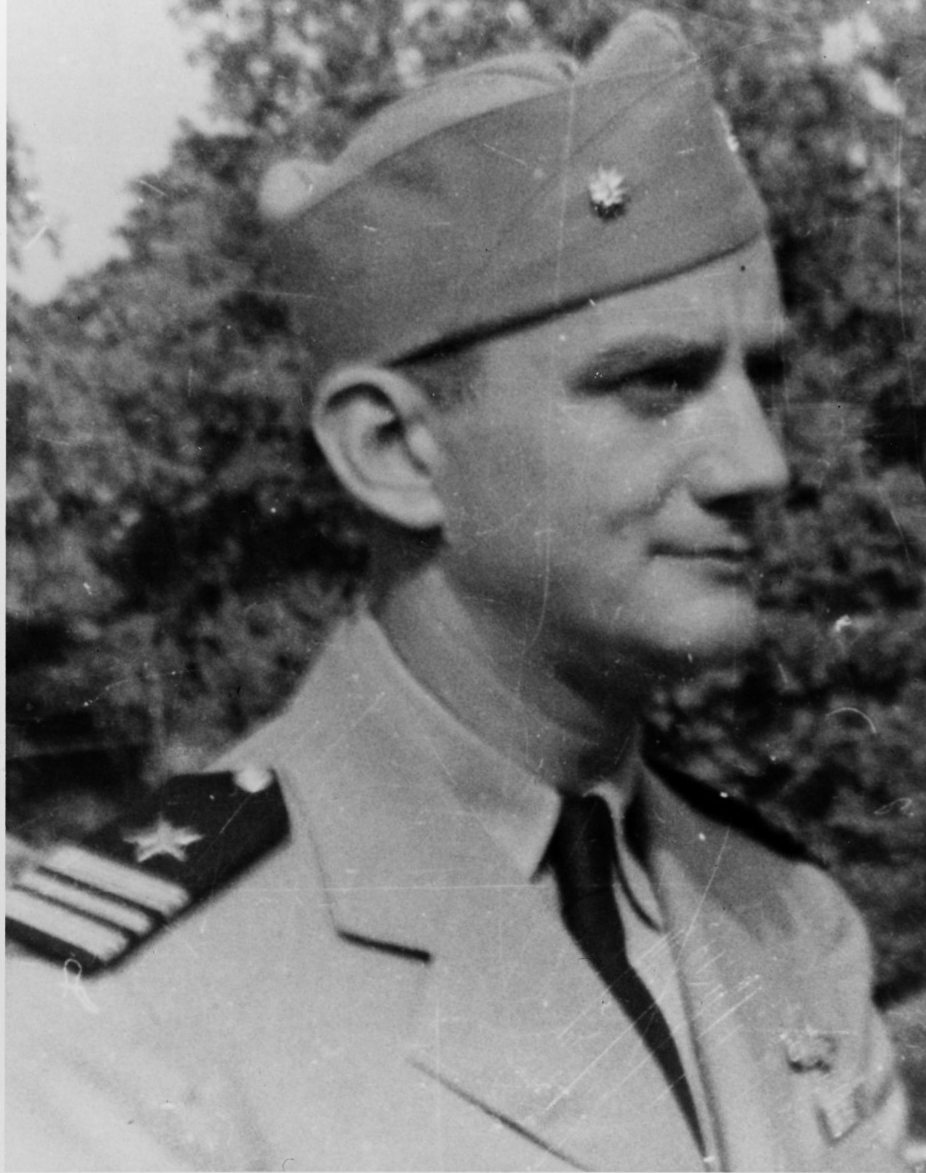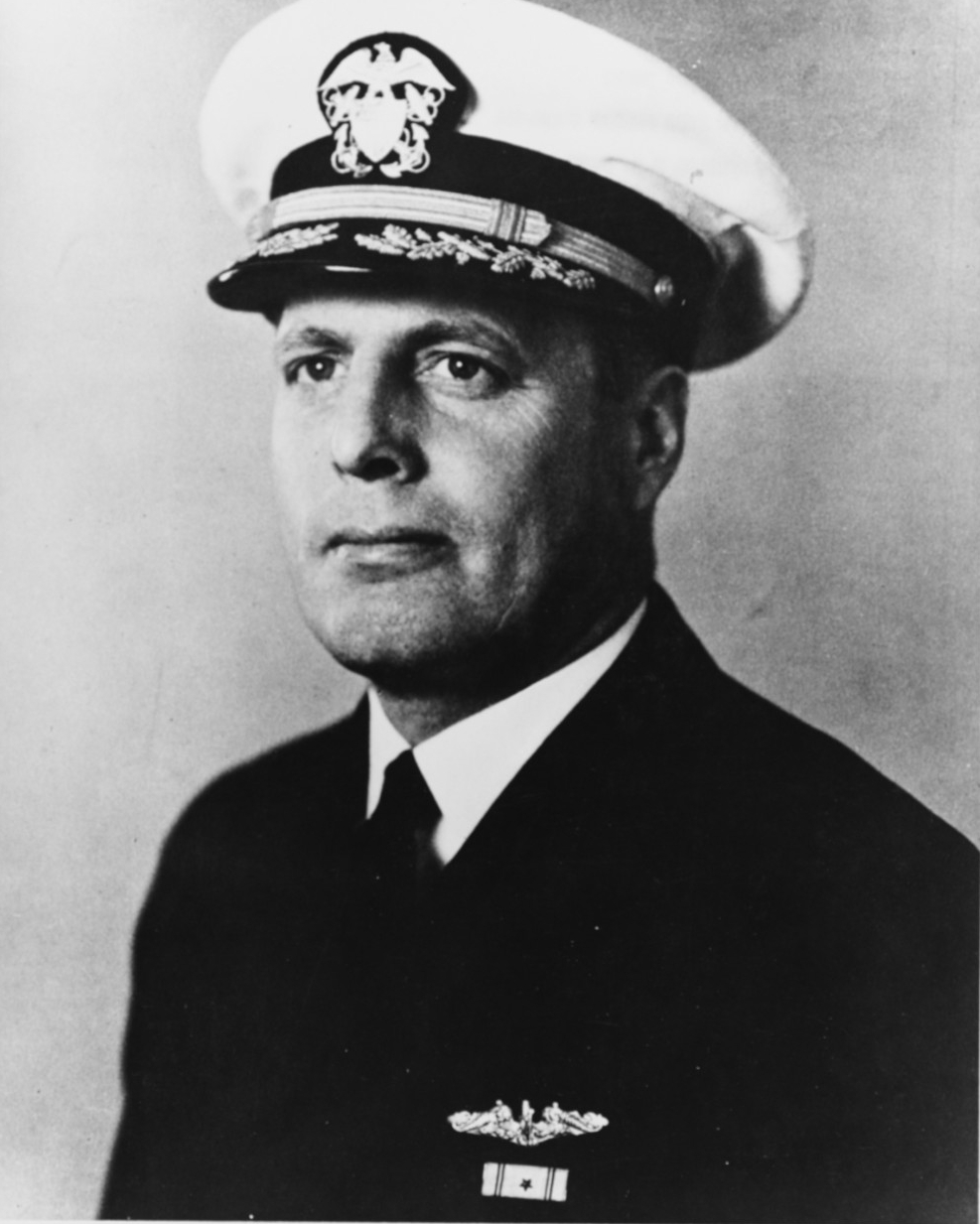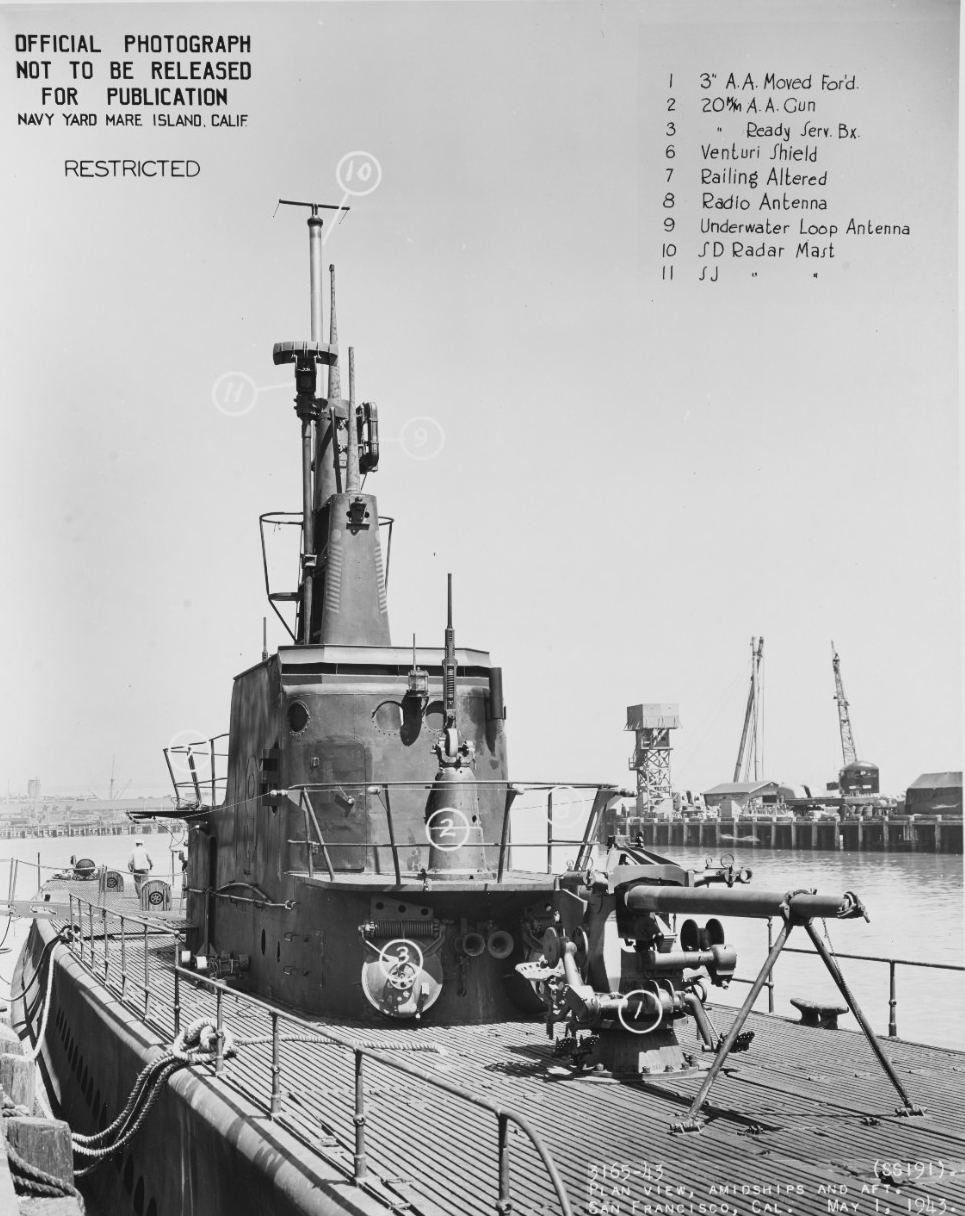Sculpin I (SS-191)
(SS-191: dp. 1,450 (surf.), 2,350 (subm.); l. 310'6"; b. 27'1"; d. 13'8"; s. 20 k. (surf.), 8.75 k. (subm.); cpl. 55; a. 1 3", 2 .50 cal. mg., 2 .30 cal. nig., 8 21" tt.; cl. Sargo)
A spiny, large-headed, broad-mouthed, usually scale-less fish of the family Cottidae. Several species are found on the Atlantic coasts of Europe and North America.
The first Sculpin (SS-191) was laid down on 7 September 1937 at Portsmouth (N.H.) Navy Yard; launched on 27 July 1938; sponsored by Mrs. J. R. Defrees; commissioned on 16 January 1939, Lt. W. D. Wilkin in command.
While on her initial shakedown cruise on 23 May 1939, the diesel-powered submarine was diverted to search for the sunken submarine, Squalus. Sighting a red smoke bomb and a buoy from the sunken submarine, she established communications, first by phone and then by signals tapped in Morse code on the hull. It was determined that Squalus was resting on the bottom in 40 fathoms of water, with both engine rooms flooded. Sculpin stood by while Falcon (ASR-2) rescued the survivors, and rendered further assistance by familiarizing the divers with the configuration of her sister ship. Sculpin aided in the salvage of the sunken vessel by sounding out the approaches to Portsmouth Harbor and preparing supplementary charts of the area where Squalus was refloated.
Lieutenant Commander Fred Connaway, USN, photographed circa 1942. On 19 November 1943, while in command of Sculpin (SS-191), he was lost when his ship was sunk. This image was published in the book United States Submarine Losses in World War II. U.S. Naval History and Heritage Command photograph, NH 50661.
Following the assistance given in the recovery of Squalus, Sculpin engaged in type training off the Atlantic coast until transferred to the Pacific Fleet. Departing Portsmouth, N.H., on 28 January 1940, she arrived at San Diego on 6 March. She sailed west on 1 April, arriving at Pearl Harbor on the 9th, where she was based for the next 18 months. Departing Pearl Harbor, 23 October 1941, she arrived at Manila on 8 November. From Cavite, she engaged in local operations and type training until war broke out.
Departing Cavite on the night of 8 December 1941, she and Seawolf (SS-197) escorted Langley (AV-3) and Pecos (AO-65) as far as San Bernadino Strait. She then took station in the Philippine Sea north of Luzon on 10 December. On the night of 10 January 1942, she intercepted two ships; made a surface attack; and scored hits on the lead ship. Forced to dive because of gunfire, Sculpin was unable to assess the results of her attack. Japanese records show that American submarines sank three Japanese ships that night; possibly Sculpin should be given credit for eliminating 3,817-ton merchantman, Akita Maru. Her first patrol terminated at Surabaja, Java, on 22 January.
Her second patrol, 30 January to 28 February, was in the Molucca Sea, east of the Celebes. On 4 February off Kendari, Java, she torpedoed a Japanese destroyer, inflicting heavy damage. After the war, Japanese records revealed that, after a submarine attack off Kendari on 4 February, destroyer Suzukaze, had been forced to run aground to avoid being sunk. Three nights later, Sculpin commenced an approach on a Japanese destroyer but was detected and forced to dive. She escaped four hours later after a heavy depth charge attack by her intended victim and five other destroyers. On the night of 17 February, she was detected while making a surface attack on a destroyer and was forced to dive. During the ensuing depth charge attack, she sustained damage to her starboard main controller and starboard shaft. On 28 February, she arrived at Exmouth, Australia, for repairs.
Her third patrol, 13 March to 27 April, out of Fremantle was in the Molucca Sea area. On 28 March, she fired a spread of three fish at a large cargo ship. The torpedoes were last seen running straight for the target, but apparently ran deep and passed under the merchant ship. A similar incident occurred on 1 April in a night attack. Sculpin, like many of her sister submarines in the early days of the Pacific war, was plagued by malfunctions of torpedo guidance systems which caused the "fish" either to take erratic courses or to run deep. The frustrated Sculpin returned to Fremantle on 27 April.
Sculpin's fourth war patrol, 29 May to 17 June, was in the South China Sea. On 8 June, she was unsuccessful in an attack on a cargo ship, again due to torpedo malfunction. A vigorous depth charge attack kept Sculpin down while the cargo ship escaped. On 13 June, near Balabac Strait, SS-191 torpedoed a cargo ship which returned fire with her deck gun and commenced to limp away. Turning on two accompanying tankers astern of the cargo ship, Sculpin made an attack but was forced to dive to prevent being rammed by one of the tankers. Surfacing at dusk, Sculpin pursued the cargo ship, but was again driven away by accurate gunfire from the maru. She shifted her attack to a tanker, leaving the ship listing and making heavy smoke. However, no sinking was confirmed. Off Cape Varella, Indochina, early on the morning of 19 June, she torpedoed a cargo ship, making a hit forward of the stack. A heavy secondary explosion was heard, and the damaged vessel was last seen headed for the shore to beach, smoke pouring from her forward hatch. Sculpin returned to Australia on 17 July.
The waters of the Bismarck Archipelago were the theatre of her fifth patrol, 8 September to 26 October. After reconnaissance operations off Thilenius and Montagu harbors of New Ireland, Sculpin commenced her search for Japanese shipping. On 28 September, she scored two hits on a cargo ship, but was forced to dive as a Japanese destroyer raced to the scene. Sculpin was under depth charge attack for three hours, during which she sustained minor damage. On 7 October, she made her first confirmed kill, the 4,731-ton transport, Naminoue Maru, off New Ireland. Escaping the Japanese escorts' countermeasures, she remained in the general area where, a week later, she intercepted a three-ship convoy in the shipping lane between Rabaul and Kavieng. Waiting until the escorting destroyer had made a patrol sweep to the opposite side of the convoy, Sculpin fired a spread of four torpedoes at the 2,000-ton cargo ship, Sumoyoshi Maru. While the blazing and sinking maru lay dead in the water, Sculpin made good her escape. Four days later, she inflicted minor damage on the light cruiser, Yura, with a hit forward of the bridge, but was driven off by the cruiser's gunfire.
Departing Brisbane on her sixth war patrol, 18 November 1942 to 8 January 1943, SS-191 worked her way past New Britain to the rich hunting grounds off Truk. After escaping a Japanese aerial attack on 11 December, she was stalking a Japanese carrier on the night of the 18th, when two destroyers attacked. One illuminated Sculpin with floodlights as both commenced heavy fire with deck guns. The submarine went deep and lay silent as the enemy depth charge attack and prolonged sonar search continued. The following night, she scored two hits on a tanker, with no sinking confirmed.
Captain John P. Cromwell, USN, photographed circa 1943. He was lost with Sculpin (SS-191) on 19 November 1943 and posthumously received the Medal of Honor for his actions at that time. This image was published in the book United States Submarine Losses in World War II. U.S. Naval History and Heritage Command photograph, NH 51733.
Sculpin arrived at Pearl Harbor on 8 January 1943, and steamed east to San Francisco for a three-month overhaul period. Returning to Pearl Harbor on 9 May, she departed Hawaii for her seventh war patrol on 24 May and operated off the northwest coast of Honshu. Three days after arriving on station, she made a surface attack on two carriers with a cruiser escort. Two heavy underwater explosions were heard as the submarine submerged. Postwar examination of Imperial Japanese Navy records revealed that the light carrier, Hiyo, had been moderately damaged by a torpedo attack in that area on 9 June. On 14 June, she damaged a cargo ship but was forced to dive and run silent to avoid the vigorous countermeasures of the maru's escorts. On 19 June, she destroyed two sampans by gunfire, leaving them aflame, with decks awash. During the remainder of the patrol, she spotted other possible targets, but they all hugged the shore, some running inside the ten-fathom line. The patrol terminated at Midway on 4 July.
Sculpin's eighth war patrol, 25 July to 17 September 1943, was off the Chinese coast and Formosa Strait. On 9 August, she torpedoed and sank the cargo/transport, Sekko Maru, off the coast of Formosa. She evaded ASW patrol craft in Taiwan Strait on 16 and 17 August. On the 21st, she intercepted an armed cargo ship and fired a spread of three torpedoes which ran "hot, straight, and normal" but did not explode. Sculpin was immediately pounced upon by escorting destroyers and was forced to dive. The cargo ship escaped in the ensuing depth charge attack. A similar torpedo malfunction occurred on 1 September, when the splash of water resulting from the torpedo striking the target's hull could be seen, but no detonation occurred. The submarine escaped the immediate counterattack of the escorts; and, after reconnaissance of Marcus Island, she returned to Midway.
Sculpin (SS-191) at the Bethlehem Steel Company shipyard San Francisco, California, on 1 May 1943, following an overhaul. This view of the forward end of her sail identifies changes recently made to the ship. Note 20mm and 3/50 guns; SD and SJ radar antennas. Official U.S. Navy photograph from the collections of the Naval History and Heritage Command, NH 97305.
Following a brief overhaul period at Pearl Harbor, Sculpin departed Hawaii on 5 November 1943. Ordered to patrol north of Truk, she was to intercept and attack Japanese forces leaving Truk to oppose the forthcoming invasion of Tarawa in the Gilbert Islands. Sculpin and two other submarines were to form a wolfpack to make coordinated attacks on the enemy. Capt. John P. Cromwell was on board Sculpin to coordinate the wolfpack operations.
After refueling at Johnston Island on 7 November, Sculpin proceeded to her assigned station. On 29 November, Capt. Cromwell was ordered to activate the wolfpack. When the submarine failed to acknowledge, the message was repeated 48 hours later. The submarine was presumed lost on 30 December and struck from the Navy list on 25 March 1944.
The account of Sculpin's final patrol was given by the surviving members of her crew, who were liberated from Japanese prisoner of war camps after V-J Day. On 16 November, she arrived on station and made radar contact with a large, high-speed convoy on the night of the 18th. Making a fast end run on the surface to attack on the morning of the 19th, she was in firing position but was forced to dive when the convoy and its escorts zagged toward her. When the Japanese task force changed course, Sculpin surfaced to make another run, but was discovered by a rear guard destroyer only 600 yards away. Crash diving, the submarine escaped the first salvo of depth charges. A second string of "ash cans" knocked out her depth gauge and caused other minor damage. She evaded the destroyer in a rain squall and attempted to come to periscope depth. The damaged depth gauge stuck at 125 feet, so the submarine broached and was again detected. She immediately submerged and the destroyer attacked with a pattern of 18 depth charges. There was considerable damage, including temporary loss of depth control. As a result, Sculpin ran beyond safe depth so that many leaks developed in the hull. So much water entered that the submarine was forced to run at high speed to maintain depth. This made tracking easy for the Japanese sonar. A second depth charge attack knocked out Sculpin's. sonar, leaving her blind.
The submarine's commanding officer, Comdr. Fred Connaway, decided to surface and give the crew of the doomed vessel a chance for survival. With her decks still awash, Sculpin's gunners manned the deck guns but were no match for the destroyer's main battery. A shell hit the conning tower and killed the bridge watch team, including Comdr. Connaway, and flying fragments killed the gun crew. The senior ship's officer surviving ordered the submarine to be scuttled. Before he opened the vents, he informed Capt. Cromwell. The captain possessed vital information concerning the forthcoming assault on the Gilbert Islands and subsequent operations. Fearing he might reveal these plans under the influence of torture or drugs, he refused to leave the stricken submarine, giving his life to escape capture. He was posthumously awarded the Medal of Honor for his act of heroism and devotion to country.
Forty-two of Sculpin's crew were picked up by the destroyer, Yamagumo. One badly wounded Sailor was thrown back in the sea because of his condition. The survivors were questioned for about ten days at the Japanese naval base at Truk; then were embarked on two aircraft carriers returning to Japan. The escort carrier, Chuyo, carried 21 of the survivors in her hold. On 2 December, the carrier was torpedoed and sunk by Sailfish (SS-192) and twenty of the American prisoners perished. One man was saved when he was able to grab hold of a ladder on the side of a passing Japanese destroyer and hauled himself on board. The other 21 survivors arrived at Ofuna, Japan, on 5 December, and, after further questioning, were sent to the Ashio copper mines for the duration of the war.
Ironically, the carrier transporting the Sculpin survivors was sunk by Sailfish, which Sculpin had helped to locate and raise after that submarine, then named Squalus, had been sunk some four and one-half years before.
Sculpin was awarded eight battle stars for her service in World War II, in addition to the Philippine Presidential Unit Citation.
__________
Sculpin (SS-494), a Tench class submarine, was to be built at Portsmouth (N.H.) Navy Yard. However, before her keel was laid, her construction was canceled on 12 August 1945.






